

Blended Course Design – Teaching in Higher Ed PODCAST. Self-regulated Learning and the Flipped Classroom – Teaching in Higher Ed PODCAST. Bonni: [00:00:00] Today on episode 110 of Teaching in Higher Ed, Robert Talbert talks about self-regulated learning and the flipped classroom.
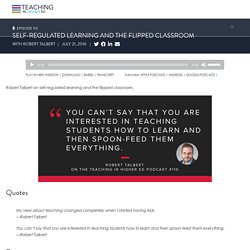
Production Credit: [00:00:11] Produced by an Innovate Learning, maximizing human potential. Bonni: [00:00:21] Welcome to this episode of Teaching in Higher Ed. I am Bonni Stachowiak and this is the space where we explore the art and science of being more effective at facilitating learning. We also share ways to increase our personal productivity approaches so we can have more peace in our lives and be even more present for our students. Bonni: [00:00:48] I’m thrilled today to be welcoming to the show Dr. Robert: [00:01:16] Thanks. Bonni: [00:01:17] We’re going to start out this episode with something a little bit personal. Applying Blended Problem-Based Learning to Accounting Studies in Higher Education; Optimizing the Utilization of Social Media for Learning. The PDF file you selected should load here if your Web browser has a PDF reader plug-in installed (for example, a recent version of Adobe Acrobat Reader).
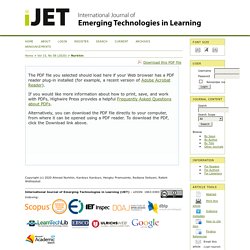
If you would like more information about how to print, save, and work with PDFs, Highwire Press provides a helpful Frequently Asked Questions about PDFs. Alternatively, you can download the PDF file directly to your computer, from where it can be opened using a PDF reader. Creating blended learning content GUIDE. What is blended learning?
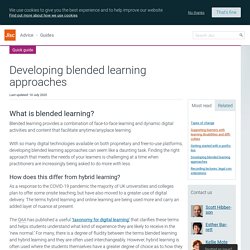
Blended learning provides a combination of face-to-face learning and dynamic digital activities and content that facilitate anytime/anyplace learning. With so many digital technologies available on both proprietary and free-to-use platforms, developing blended learning approaches can seem like a daunting task. Finding the right approach that meets the needs of your learners is challenging at a time when practitioners are increasingly being asked to do more with less. How does this differ from hybrid learning?
As a response to the COVID-19 pandemic the majority of UK universities and colleges plan to offer some onsite teaching, but have also moved to a greater use of digital delivery. How to Grow a Classroom Culture That Supports Blended Learning CHAPTER. The excerpt below is from the book “Moonshots in Education: Launching Blended Learning in the Classroom,” by Esther Wojcicki, Lance Izumi and Alicia Chang.
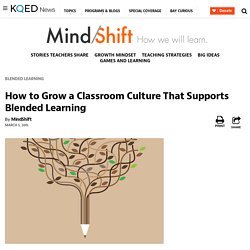
This excerpt is from the chapter entitled “Trick in the Blended Classroom,” written by Wojcicki. It all started in 1987, when I got a grant from the State of California. The state sent me eight Macintosh computers, never asking if I knew how to use them, and when they arrived I had no idea how to even turn them on. I realized then that I was going to fail if I didn’t get some help quickly. I looked around for colleagues who could help, but none of them had any idea. The students were absolutely thrilled to help me (can you imagine being asked to help a teacher?!)
I was soon sold on the idea of collaboration, respect, and trust in the classroom. Computers, tablets, and other electronic devices alone are not going to change the classroom. T = trust R = respect I = independence C = collaboration K = kindness Respect is part of trust. BlendKit COURSE. Introduction The BlendKit Course is a set of subject matter neutral, open educational resources related to blended learning developed by Dr.
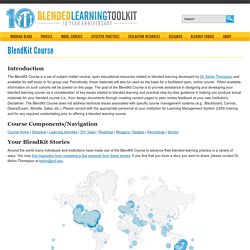
Kelvin Thompson and available for self-study or for group use. Periodically, these materials will also be used as the basis for a facilitated open, online course. The goal of the BlendKit Course is to provide assistance in designing and developing your blended learning course via a consideration of key issues related to blended learning and practical step-by-step guidance in helping you produce actual materials for your blended course (i.e., from design documents through creating content pages to peer review feedback at your own institution). Disclaimer: The BlendKit Course does not address technical issues associated with specific course management systems (e.g., Blackboard, Canvas, Desire2Learn, Moodle, Sakai, etc.). Course Components/Navigation Your BlendKit Stories. Blended Learning PINTEREST BOARD. 5 Effective Blended Learning Strategies BLOG POST. Blended learning, the practice of integrating online instructional components into traditional teaching methods, first became popular in the late 1990s when web-based content became available in households and classrooms.
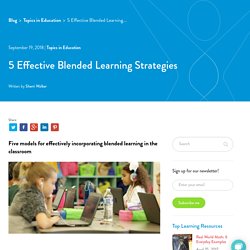
This teaching method combines teacher-led instruction with digital technology and allows students some degree of control over the pace, time, and location of their learning. Tips For Implementing Blended Learning INFOGRAPHIC. Blended learning is one of the most popular training solutions in organizations today.
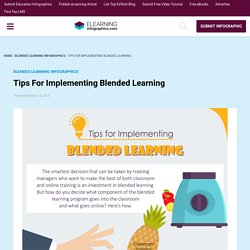
And for many reasons. But how you do know what should go where? After all, both are highly effective. So how do you come up with the perfect blend? Are there any time-tested proportions for deciding on the blend? There are many things to consider when coming up with the right blend – the purpose, the audience, the need for repeatability and practice, the need for live sessions, the complexity of the content being taught, the need to offer learners a self-test to let them know where they stand, the need for some kind of performance support long after the training is over, the need to offer learners the opportunity to revisit content they have learned at their convenience, etc.
Although coming up with the ideal blend sounds tricky, it is not complicated really. A breakdown of Blended Learning - What it is, models, stats and what the future holds INFOGRAPHIC. A breakdown of Blended Learning - What it is, models, stats and what the future holds.
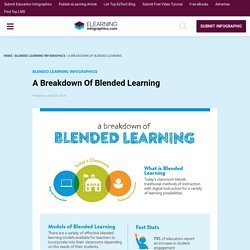
What is blended learning? Today's classroom blends traditional methods of instruction with digital instruction for a variety of learning possibilities. Models of blended learning There are a variety of effective blended learning models available for teachers to incorporate into their classrooms depending on the needs of their students. Blended learning effectiveness: the relationship between student characteristics, design features and outcomes ARTICLE. This review presents research about blended learning effectiveness from the perspective of learner characteristics/background, design features and learning outcomes.
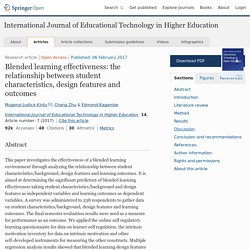
It also gives the factors that are considered to be significant for blended learning effectiveness. The selected elements are as a result of the researcher’s experiences at a Ugandan university where student learning faces challenges with regard to learner characteristics and blended learning features in adopting the use of technology in teaching and learning. We have made use of Loukis, Georgiou, and Pazalo (2007) value flow model for evaluating an e-learning and blended learning service specifically considering the effectiveness evaluation layer.
This evaluates the extent of an e-learning system usage and the educational effectiveness. Blended learning: the new normal and emerging technologies ARTICLE. Adams Becker, S., Cummins, M., Davis, A., Freeman, A., Hall Giesinger, C., & Ananthanarayanan, V. (2017).

NMC horizon report: 2017 higher Education Edition. Austin: The New Media Consortium. Google Scholar Alhabeeb, A. M. (2015).